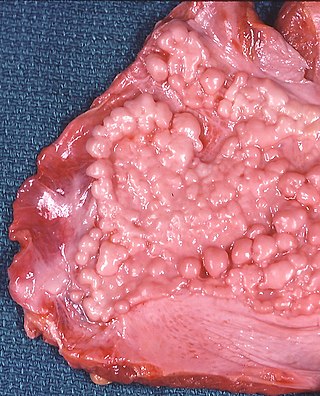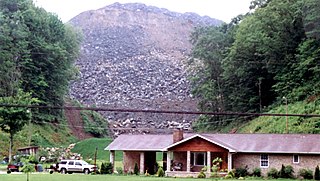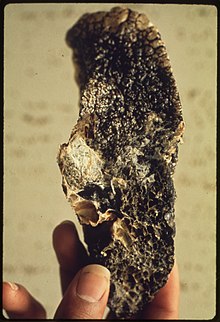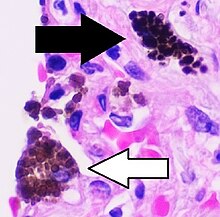Coal dust is a fine-powdered form of coal which is created by the crushing, grinding, or pulverization of coal rock. Because of the brittle nature of coal, coal dust can be created by mining, transporting, or mechanically handling it.

Pneumoconiosis is the general term for a class of interstitial lung disease where inhalation of dust has caused interstitial fibrosis. The three most common types are asbestosis, silicosis, and coal miner's lung. Pneumoconiosis often causes restrictive impairment, although diagnosable pneumoconiosis can occur without measurable impairment of lung function. Depending on extent and severity, it may cause death within months or years, or it may never produce symptoms. It is usually an occupational lung disease, typically from years of dust exposure during work in mining; textile milling; shipbuilding, ship repairing, and/or shipbreaking; sandblasting; industrial tasks; rock drilling ; or agriculture. It is one of the most common occupational diseases in the world.

Asbestosis is long-term inflammation and scarring of the lungs due to asbestos fibers. Symptoms may include shortness of breath, cough, wheezing, and chest tightness. Complications may include lung cancer, mesothelioma, and pulmonary heart disease.

Silicosis is a form of occupational lung disease caused by inhalation of crystalline silica dust. It is marked by inflammation and scarring in the form of nodular lesions in the upper lobes of the lungs. It is a type of pneumoconiosis. Silicosis, particularly the acute form, is characterized by shortness of breath, cough, fever, and cyanosis. It may often be misdiagnosed as pulmonary edema, pneumonia, or tuberculosis. Using workplace controls, silicosis is almost always a preventable disease.

The Mine Safety and Health Administration (MSHA) is a large agency of the United States Department of Labor which administers the provisions of the Federal Mine Safety and Health Act of 1977 to enforce compliance with mandatory safety and health standards as a means to eliminate fatal accidents, to reduce the frequency and severity of nonfatal accidents, to minimize health hazards, and to promote improved safety and health conditions in the nation's mines. MSHA carries out the mandates of the Mine Act at all mining and mineral processing operations in the United States, regardless of size, number of employees, commodity mined, or method of extraction. David Zatezalo was sworn in as Assistant Secretary of Labor for Mine Safety and Health, and head of MSHA, on November 30, 2017. He served until January 20, 2021. Jeannette Galanais served as Acting Assistant Secretary by President Joe Biden on February 1, 2021 until Christopher Williamson took office on April 11, 2022.

The Federal Coal Mine Health and Safety Act of 1969, U.S. Public Law 91-173, generally referred to as the Coal Act, was passed by the 91st United States Congressional session and enacted into law by the 37th President of the United States Richard Nixon on December 30, 1969.
Safety and Health in Mines Convention, 1995 is an International Labour Organization Convention. It was adopted at the 82nd International Labour Conference (ILC) of the International Labour Organization (ILO). The ILO is an agency under the United Nations that deals with international labor issues while promoting workers rights and opportunities. One of ILO's goals is to hold annual labor conventions to create legally binding contracts for participating nations to ratify. During the Safety and Health in Mines Convention (C176), it was recognized that there are inherent hazards in the mining workplace, and a need for a convention was mandatory.
Progressive massive fibrosis (PMF), characterized by the development of large conglomerate masses of dense fibrosis, can complicate silicosis and coal worker's pneumoconiosis. Conglomerate masses may also occur in other pneumoconioses, such as talcosis, berylliosis (CBD), kaolin pneumoconiosis, and pneumoconiosis from carbon compounds, such as carbon black, graphite, and oil shale. Conglomerate masses can also develop in sarcoidosis, but usually near the hilae and with surrounding paracicatricial emphysema.
Occupational lung diseases comprise a broad group of diseases, including occupational asthma, industrial bronchitis, chronic obstructive pulmonary disease (COPD), bronchiolitis obliterans, inhalation injury, interstitial lung diseases, infections, lung cancer and mesothelioma. These can be caused directly or due to immunological response to an exposure to a variety of dusts, chemicals, proteins or organisms. Occupational cases of interstitial lung disease may be misdiagnosed as COPD, idiopathic pulmonary fibrosis, or a myriad of other diseases; leading to a delay in identification of the causative agent.
Caplan's syndrome is a combination of rheumatoid arthritis (RA) and pneumoconiosis that manifests as intrapulmonary nodules, which appear homogeneous and well-defined on chest X-ray.
The Institute of Occupational Medicine (IOM) was founded in 1969 by the National Coal Board (NCB) as an independent charity in Edinburgh, UK and retains its charitable purpose and status today. The "Institute" has a subsidiary, IOM Consulting Limited, which became fully independent in 1990 and now celebrates its 25th year within the IOM Group as an independent consultancy and also the commercial part of the IOM organization. It specializes in asbestos surveys and services, occupational hygiene services, nanotechnology safety, laboratory analysis and expert witness consulting services. IOM is therefore one of the UK's major independent "not for profit" centres of science in the fields of environmental health, occupational hygiene and occupational safety.
The ILO International Classification of Radiographs of Pneumoconioses is a system of classifying chest radiographs (X-rays) for persons with a form of pneumoconiosis. The intent is to provide a standardized, uniform method of interpreting and describing abnormalities in chest x-rays that are thought to be caused by prolonged dust inhalation. In use, it provides a system for both epidemiological comparisons of many individuals exposed to dust and evaluation of an individual's potential disease relative to established standards.
Mineral dust airway disease is a general term used to describe complications due to inhaled mineral dust causing fibrosis and narrowing of primarily the respiratory bronchioles. It is a part of a group of disorders known as pneumoconioses which is characterized by inhaled mineral dust and the effects on the lungs.
Stannosis is an occupational, non-fibrotic pneumoconiosis caused by chronic exposure and inhalation of tin. Pneumoconiosis is essentially when inorganic dust is found on the lung tissue; in this case, caused by tin oxide minerals. Dust particles and fumes from tin industries, stannous oxide (SnO) and stannic oxide (SnO2), are specific to stannosis diagnoses. Hazardous occupations such as, tinning, tin-working, and smelting are where most cases of stannosis are documented. When melted tin ions are inhaled as a fume, the tin oxides deposit onto the lung nodules and immune response cells. If a worker is exposed to tin oxides over multiple events for an extended time, they are at risk of developing stannosis.

Mine safety is a broad term referring to the practice of controlling and managing a wide range of hazards associated with the life cycle of mining-related activities. Mine safety practice involves the implementation of recognised hazard controls and/or reduction of risks associated with mining activities to legally, socially and morally acceptable levels. While the fundamental principle of mine safety is to remove health and safety risks to mine workers, mining safety practice may also focus on the reduction of risks to plant (machinery) together with the structure and orebody of the mine.

Emphysema is any air-filled enlargement in the body's tissues. Most commonly emphysema refers to the enlargement of air spaces (alveoli) in the lungs, and is also known as pulmonary emphysema.

Occupational dust exposure can occur in various settings, including agriculture, construction, forestry, and mining. Dust hazards include those that arise from handling grain and cotton, as well as from mining coal. Wood dust, commonly referred to as "sawdust", is another occupational dust hazard that can pose a risk to workers' health.

Environmental justice and coal mining in Appalachia is the study of environmental justice – the interdisciplinary body of social science literature studying theories of the environment and justice; environmental laws, policies, and their implementations and enforcement; development and sustainability; and political ecology – in relation to coal mining in Appalachia.
A tapered element oscillating microbalance (TEOM) is an instrument used for real-time detection of aerosol particles by measuring their mass concentration. It makes use of a small vibrating glass tube whose oscillation frequency changes when aerosol particles are deposited on it increasing its inertia. TEOM-based devices have been approved by the U.S. Environmental Protection Agency for environmental air quality monitoring, and by the U.S. Mine Safety and Health Administration for monitoring coal dust exposure for miners to prevent several respiratory diseases.
J. Davitt McAteer is an American lawyer, author, and activist from Fairmont, West Virginia. McAteer was appointed to the position of assistant secretary for the Mine Safety and Health Administration from 1993 to 2000 under President Bill Clinton. Throughout his career, McAteer has been an advocate for safe working conditions for miners, particularly in the coal industry. After the Upper Big Branch Mine disaster of 2010, where an explosion caused by negligence led to the death of 29 miners, McAteer Served on Governor Earl Ray Tomblin's independent investigation panel to determine the cause of the explosion. McAteer is the author of "Monongah: The Tragic Story of the 1907 Monongah Mine Disaster".











